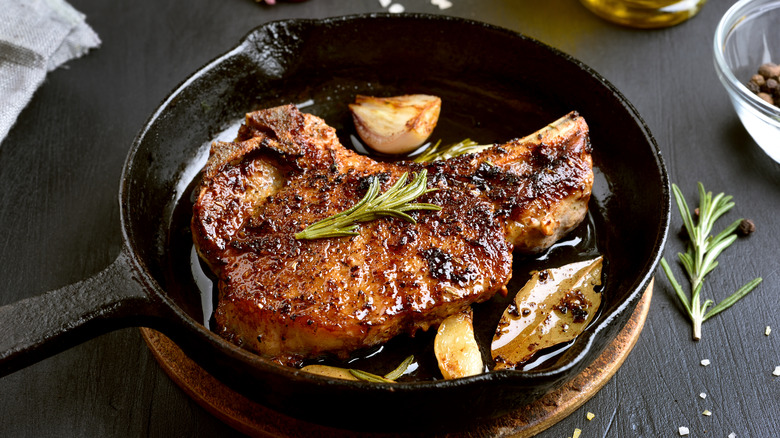The Real Reason Rachael Ray Always Cooks Meat On A Flat Surface
Please don't call her a chef! Food Network's Rachael Ray regularly dismisses the title "chef" for the more blue-collar title of a cook since Ray received no formal culinary training. According to Insider, Ray's in a distinguished group of successful celebrity cookss without degrees from institutes like the Culinary Institute of America or Le Cordon Bleu, including the beloved Ina Garten, Gordon Ramsay, Tom Colicchio, Martha Stewart, Nigella Lawson, and even the first American chef to earn two three-star ratings from the Michelin Guide, Thomas Keller of "French Laundry."
Her lack of a culinary degree hasn't stopped Ray from parlaying her early beginnings at her family's restaurant into a culinary conglomerate, though. Food Network president Courtney White believes that Ray's experience, or lack thereof, resonated with home cooks, proving you don't need to be a professional chef to be a good cook. Ray's empire contains a monthly magazine, "Everyday with Rachael Ray," a daytime talk show, multiple Food Network cooking shows, almost 30 cookbooks, dog products, and a line of cooking merchandise (via Food Network). Ray, known early on for her "30-Minute Meal" concept, has worked her way into viewers' hearts, being called "the most down-to-earth TV star on the planet" by Newsweek. At the same time, Forbes found Ray to be the No. 2 "Most Trusted Celebrity." (Naturally, Tom Hanks was No. 1.)
With decades of cooking experience, Ray has learned her way around the kitchen, so when she tells us what makes her steaks "yum-o," we should take note.
Cooking on a plancha
According to an Instagram post, Rachael Ray uses a flat, cast iron surface when cooking proteins, regardless of whether she's cooking indoors or outside. Unlike cooking on a grill, where half the surface of the meat is in contact with the hot grate, a flat surface or plancha, ensures the entire cut of meat touches the pan, benefitting from the Maillard reaction, according to ScienceDirect. Maillard is a scientific reaction that occurs when proteins and sugars bond, creating a complex new flavor and aroma. Results of the Maillard reaction can be found in many dishes we cook regularly. It is responsible for the dark crust we aim for on the outside of our steaks, but it's also found on bread crust, in caramel sauce, and roasted potatoes.
As Serious Eats explains, to achieve the Maillard reaction, you should cook with high heat, as Ray demonstrates in the video. Her cast iron pan is at a smoking point, with an appropriate oil added to keep it from burning. The protein needs to be dry, so chefs advise using a paper towel to remove moisture from the meat before cooking. You can also dehydrate the meat's surface by leaving it uncovered in your refrigerator overnight. Finally, you need time. Once you place the protein in the hot pan, leave it until it releases itself. Any earlier will result in ripping the surface of the meat and won't give you that desired crust.
Armed with all this knowledge and craving for a ribeye, it's time to heat up that cast iron pan and get cooking. Hope it's delish!

